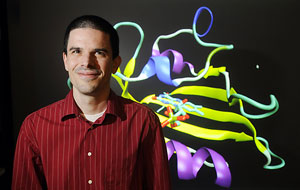
Hello, Anton
PSC Hosts Powerful Supercomputer
by Michael Schneider
For the next 12 months, the Pittsburgh Supercomputing Center (PSC) will be hosting a guest named Anton. A groundbreaking supercomputer, Anton will help biomedical researchers around the country resolve fundamental questions about proteins and advance efforts to design new therapeutic drugs.

Markus Dittrich stands in front of a rendition of a photo receptor protein.
Named for Anton van Leeuwenhoek, the father of microscopy, Anton will serve as a “computational microscope,” enabling researchers to see more deeply and clearly into sub-microscopic realms where proteins carry out their life-sustaining functions. Anton, on loan from D. E. Shaw Research in New York City, will do this by running a computational application called “molecular dynamics” (MD) far better than any other supercomputer is able to do.
“Molecular dynamics is a way to simulate the motion of proteins with a computer,” explained Markus Dittrich, biomedical scientist at the National Resource for Biomedical Supercomputing (NRBSC) at PSC. “This allows scientists to better understand proteins’ function and also how they interact with each other or other biomolecules such as DNA or drugs.”
With static protein structures as a starting point, MD simulations calculate protein movement as a series of conformations, each computed at separate time intervals. This interval has to be very short, usually a femtosecond (10-15 second), to capture the rapid atomic motions happening within the protein. An MD simulation must perform an enormous number of these tiny interval calculations to capture even a very short period of real time—a million of them, for instance, to cover only a nanosecond (10-9 second).
“With most proteins,” said Dittrich, “the interesting things happen on timescales of milliseconds (10-3) or longer.” But even the most advanced MD simulations on state-of-the-art supercomputing resources typically reach only into the hundreds of nanoseconds, with only a few simulations to date having surpassed the microsecond (10-6) threshold.
Built to run MD and nothing else—unlike most supercomputers, which are general purpose—Anton does MD up to 100 times faster than conventional supercomputers, making it possible for simulations to finally reach and extend beyond a millisecond of biological time. The availability of these extended timescales will greatly benefit the study of a large number of important biological processes. Among them are the mode of operation of membrane transporters, cellular machines responsible for shuttling nutrients and other biomolecules into and out of cells, and “protein folding,” the process by which a newly hatched protein, initially a linear chain of amino acids, folds into its functional 3-D shape. Both transport and folding events typically occur on a timescale ranging from many microseconds to milliseconds and beyond, and have thus far been inaccessible to MD simulations.
“For the first time, Anton will allow us to get a glimpse at how important biomolecular systems work at these extended timescales,” says Dittrich. “These new insights will be crucial for gaining a better understanding of disease and the development of therapeutic drugs.”
The National Institute of General Medical Sciences (NIGMS) awarded a two-year, $2.7 million “Grand Opportunities” grant to NRBSC to host Anton, developed by D. E. Shaw Research, a private research laboratory founded by David E. Shaw, a former hedge fund manager with a Ph.D. from Stanford. Having made a fortune on Wall Street with computer modeling, Shaw in 2001 began concentrating on computational biochemistry and the design of Anton.
While there are several Anton systems used internally at D. E. Shaw Research, NRBSC at PSC is hosting the first one made available to the general scientific community. Scientists from around the country submitted 67 proposals to conduct studies using Anton, which are in review by a committee convened by the National Academies of Science. “We can award about 45,” said Dittrich. “And this quantity of proposals is quite amazing for a focused resource like this.”
“This is an incredibly exciting project in many ways,” said Joel Stiles, director of NRBSC, associate professor of biological sciences and a member of the Lane Center for Computational Biology at Carnegie Mellon. “With this very generous gift from D. E. Shaw Research and the funding provided by National Institutes of Health, we are deploying a tool of unprecedented power for the benefit of biomedical researchers nationally. We hope and expect that this project will help to significantly advance our understanding of biomolecular structure and function, and to spur ongoing scientific and technological development in MD research and in other areas of computational biology.”
Photo credit: Copyright ©, Pittsburgh Post-Gazette, 2010, All Rights Reserved. Reprinted with permission.